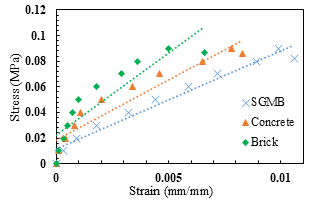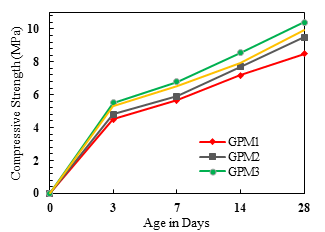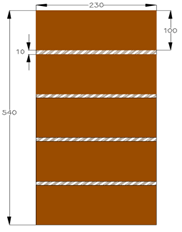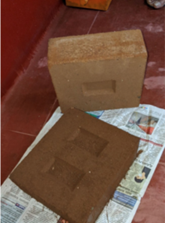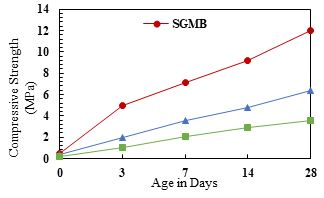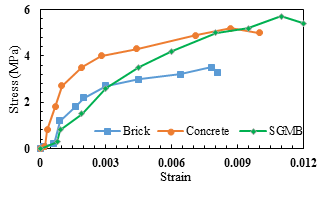Experimental Study on the Compressive Strength of Masonry Blocks with Geopolymer Mortar
- Ramya.M.S.
- Shashishankar.A.
- -345
- Dec 11, 2023
- Social Welfare
Experimental Study on the Compressive Strength of Masonry Blocks with Geopolymer Mortar
Ramya.M.S.1*, Shashishankar.A.2
1*Research Scholar, Department of Civil Engineering, VTU-RRC, Belagavi
2Professor and Head, Department of Civil Engineering, AMCEC, Bengaluru
DOI: https://doi.org/10.51244/IJRSI.2023.1011028
Received: 03 November 2023; Accepted: 08 November 2023; Published: 11 December 2023
ABSTRACT
Masonry units are the major building materials used in construction work. There are several masonry units available in the market today. Some of the widely used masonry units are burnt clay bricks, concrete blocks, fly ash blocks, compressed stabilized soil/earth blocks, geopolymer mud blocks, geopolymer concrete blocks, and so on. These blocks are used for the construction of load bearing structure. To bond two masonry units together, mortar plays a vital role. Fly ash based geopolymer mortar has been used in this study. The strength of masonry units namely bricks, concrete blocks and stabilized geopolymer blocks masonry with geopolymer mortar has been individually studied and the results have been tabulated. From this study, it was found that the stabilized geopolymer mud blocks are suitable in the construction of load bearing walls and for other structural purposes. The failure pattern revealed visible vertical fissures and ultimately spalling of brick prism blocks.
Keywords: burnt clay brick, concrete block, geopolymer, fly ash, mortar, mud blocks, compressive strength
INTRODUCTION
The history of masonry construction dates back thousands of years, with evidence of its use found in ancient civilizations around the world. One of the earliest known masonry techniques was dry-stone construction, in which stones were stacked and arranged without the use of mortar. This method was employed by ancient cultures such as the Egyptians, who built the pyramids, and the Inca civilization, known for its intricate stone masonry at Machu Picchu.
The transition to more sophisticated masonry techniques, involving mortar as a binding agent, occurred as early as 4000 BCE. The Romans made significant advancements in masonry, introducing concrete as a versatile building material and constructing structures like the Colosseum and aqueducts.
During the Middle Ages, Gothic architecture saw the construction of magnificent cathedrals and castles in Europe, showcasing intricate stonework and the use of pointed arches and ribbed vaults. Masonry continued to evolve with the Renaissance, where classical principles were revived, leading to the construction of elegant palaces and public buildings. In more recent history, the Industrial Revolution brought about innovations in brick and concrete production, making masonry construction more efficient and affordable. Even in the modern era, masonry is still a widely utilized building method for both residential and commercial constructions. It frequently combines traditional craftsmanship with cutting-edge technology to create long-lasting and visually beautiful construction. As time went on, people started binding materials with bricks and stones that contained lime. The building’s strength changed when the mortar mix’s composition was altered. The many materials, mixing, and ramming have all been credited with the mortar’s longevity. The Indian custom of combining lime and water and pounding it for an extended period of time, either with or without adding crushed surkhi, brick powder produced high quality mortar.
As an alternative to the current bricks/concretes, a new class of building materials known as geopolymers has arisen with the potential to completely transform the building and construction sector. They produce low-cost, environmentally beneficial Geo-polymer block technology. This technology delivers higher early strength, a binder free of Portland cement, and a superior life-cycle cost.
Hence, we can conclude that, the construction industry has seen a revolutionary shift from sun baked clay bricks to brick kilns, and from gypsum mortar to lime and cement. This progression from bricks to concrete blocks, hollow blocks, and geopolymer mud blocks has been remarkable. With the nation’s goal of sustainable development and environmental protection in mind, industry has opened up new opportunities in this area.
LITERATURE REVIEW
Using stabilised mud blocks, clay bricks, and stabilised soil-sand blocks, Venu Madhava Rao K, et al. studied on masonry bond-compressive strength behaviour. They concluded that the bond strength of the masonry improved with the addition of soil or lime to the mortar mixture, and that the masonry bond strength increased as the mortar’s compressive strength increased [1]. B. V. Venkatarama Reddy and A. Gupta, used cement, stone quarry dust, and natural red loamy soil to create soil blocks. They found that the cement concentration had a significant impact on the block’s compressive strength, which increased as the cement percentage increased [2]. A uniaxial compressive stress-strain model for clay brick masonry was created by Kaushik et al. Prisms’ elastic modulus and compressive strength were measured experimentally. Regression analysis of experimental data resulted in the development of an empirical equation for estimating the compressive strength of masonry prisms as a function of the compressive strengths of brick units and mortar. An analytical model was created to represent the burnt clay brick masonry’s stress-strain curve [3]. The compressive, flexural, and bond strengths of brick masonry with lime mortar were ascertained by Costigan and Pavia. It was investigated and observed that the compressive strength of masonry is insensitive to changes in bond strength when the masonry units are more rigid than the mortar. Two failure scenarios were noted: bond failure when brick is stiffer than mortar and vertical splitting when mortar is stiffer than brick [4]. Vimala and Kumarasamy investigated the stability of mud block masonry stabilisation by varying mortar proportions. It was found that the stabilised mud block and prism exhibited a higher dry compressive strength than a wet compressive strength. The dry and wet strength of prisms increased as mortar strength increased [5]. According to M.K. Maroliya, structural elements like walls can develop crack patterns, and walls built with concrete blocks have lower strength than walls made of brick masonry, but their construction costs are much lower [6]. Ernesto S. Fortes, Guilherme A. Parsekian, and Fernando S. Fonseca examined the compressive strength of masonry units and un-grouted and grouted masonry. According to this research, the compressive strength of the masonry increases as the compressive strength of the units increases [7]. The usage of geopolymers addresses two new challenges. By minimizing the usage of OPC, carbon dioxide emissions from the manufacture of regular Portland cement can be reduced, as can the successful use of industrial and commercial waste products such as fly ash, slags from thermal power plants, and so on [8-9]. Researchers have shown that geopolymer masonry units may be made from class F fly ash, which is widely available around the world. It is an alternative building material and is said to exhibit better strength, properties and durability characteristics than the available building materials [10 – 14]. The study on the enhancement of geopolymer binders by incorporating waste materials—rockwool, granulated slag, basalt and silica fume—activated with alkaline substances recommends reusing of industrial wastes to manufacture green geopolymer binders, contributing to sustainable waste management and eco-friendly construction materials. An optimal 28-day curing time is identified, showing increased geopolymerization and crystal size. [16 – 17].
MATERIALS AND METHODS
Locally available burnt clay bricks from a standard manufacturer, indexed as BBI of size (225x100x70) mm were obtained and used for the experiments. A set of experiments based on the IS code were conducted on single unit of brick to determine the following characteristics of the bricks such as dimensionality, water absorption initial rate of absorption and compressive strength of brick. Water absorption test was conducted as specified by IS 3495 (Part 2) – 1992. Initial rate of absorption (IRA) was conducted as per IS 1905-1987. IRA is determined by dipping the dry masonry unit in a 3mm layer of water for 1 minute and is specified in terms of kg/m2/min. The compressive strength of brick was determined as per IS 1077 – 1992. The stress-strain characteristics were also determined. Brick prism of size (225x100x 390) mm was constructed along with the geopolymer mortar maintaining 10 mm mortar thickness throughout the prism. The brick masonry prism specimens were cured and tested for compressive strength at 3, 7, 14 and 28 days as per ASTM C1314. A stress – strain curve was plot at the age of 28 days and the relevant parameters and the mode of failure was noted down. Similarly, the same set of tests were carried out on each unit of concrete block as per IS codal procedures in order to determine its characteristics. Solid concrete blocks of size (400 x 200 x150) mm were used. Water absorption of block was calculated following the procedure mentioned in IS 3495 (Part 2) – 1992. The initial rate of absorption (IRA) and the compressive strength of concrete block was done as per IS 2185 (Part 1) – 2005. The stress – strain curve was also plot. Concrete block prisms of size (400 x 200 x 470) mm were constructed and tested for compressive strength as per ASTM C1314 and stress-strain parameters.
Stabilized Geopolymer Mud Blocks (SGMB) of size (230 x 110 x 100) mm were cast using manually operated block making machine giving desired amount of pressure. The raw materials namely, Class F Fly ash as binder, Mud as aggregate and 10 M Sodium hydroxide and Sodium silicate as alkaline solution in the ratio of 1:1.5 were used in the process. The ratio of solution and binder was maintained at 0.4 and binder to aggregate ratio 1:1 for the blocks. These materials were thoroughly mixed and fed into the machine mould and cured in ambient atmosphere, thus desired blocks were obtained. These blocks were tested as per IS codal testing procedures for water absorption, initial rate of absorption (IRA), dimensionality, density and results were tabulated. Compressive strength of SGMB was tested as per IS 1077. The stress – strain curve for SGMB was plot and modulus of elasticity determined.
A total of four different mortars were used for selecting an optimum mortar for the construction of masonry prisms. Fly ash based geopolymer mortar with 10M Sodium hydroxide and Sodium silicate as alkaline solution in the ratio of 1:1.5, binder to aggregate ratio of 1: 4 and solution to fly ash mix of ratios 0.3 (GPM1), 0.4 (GPM2), 0.5 (GPM3) and 0.6 (GPM4) were chosen for testing. The standard test for compressive strength of mortar was carried out following IS 2250-1981, which involves compression testing on a set of 50 mm cubes. Compressive strength of each of the mortars were analyzed and results were tabulated.
The construction and test procedures were carried out according to the guidelines provided in the code ASTM C1314 -14. This code covers the test procedures for masonry prism construction and testing, and procedures for determining the compressive strength of masonry. The code suggests testing of masonry prisms of minimum of two units high with the prism’s height-to-thickness ratio, hp/tp, between 1.3 and 5.0 for determining compressive strength of the masonry. Stack bonded masonry prisms were cast. Four to five masonry blocks were placed one above the other with mortar in between maintaining a mortar thickness of 10 mm. Fig. 4 shows the geometry of stack bonded prism and dimensions of each stacked masonry prisms were measured A set of prisms were built using the two mortars namely, GPM1, GPM2, GPM3 and GPM4. The test for compressive strength for burnt clay brick prisms, concrete block prisms and stabilized geopolymer mud block prisms with the geopolymer mortar after a period of 3, 7, 14, 28 days was carried out by gradually applying axial loading in the center of the bearing surface and results were tabulated. The stress strain curve was plotted to evaluate the structural behavior of the prisms and initial tangent modulus was calculated.
RESULTS AND DISCUSSION
1) Compressive Strength of Burnt Clay Brick: The properties of burnt bricks like dimensionality, water absorption test, initial rate of absorption, density of the blocks tested as per IS code is as shown in Table 1. The tests were conducted as per IS 1077 – 1992, water absorption of the bricks as per IS 3495 (Part 2) – 1992, was found to be 10.65%. IRA of the bricks as per ASTM C67 was found to be 1.5 kg/m2/min which is less than 5 kg/m2/min which is within the specified limits. The average density of the brick was in the range of 1600 to 2000 kg/m3 which satisfy the codal requirements. As per IS 1077: 1992, the dimensionality test of the brick units was conducted and the test results of the blocks were within the permissible limits of codal provisions. The compressive strength of the masonry brick tested as per IS 1077: 1992 was found to be around 5 MPa. The stress strain characteristic of the brick is as shown in Fig.3. The Young’s modulus of brick was found to be 8 GPa and Poisson’s Ratio is 0.22. The properties are tabulated in Table 1.
Table I. Properties of Burnt Clay Bricks
| Sl. No. | Property | Value | Codal Provision |
| 1 | Dimension | (225x100x70) mm | – |
| 2 | Water Absorption | 10.65 % | < 20 % |
| 3 | IRA | 1.5 kg/m2/min | < 5 kg/m2/min |
| 4 | Dry Density | 1650 kg/m3 | 1600 – 2000 kg/m3 |
2) Compressive Strength of Solid Concrete Block: The properties of concrete block like dimensionality, water absorption test, initial rate of absorption, density of the blocks tested as per IS code is as shown in Table 1. The tests were conducted as per IS 2185-2005, water absorption of the blocks was found to be 5%. IRA of the blocks as per IS 2185: 2005 concrete blocks was found to be 1.2 kg/m2/min which is less than 5 kg/m2/min. The density of the masonry block was in the range of 1200 to 2000 kg/m3 which satisfy the codal requirements. As per IS 1077:1992, the dimensionality test of the masonry units was conducted and the test results of the blocks are within the permissible limits of codal provisions. The compressive strength of the masonry block tested as per IS 1077: 1992. It was observed that the compressive strength of the masonry units is around 12.5 MPa. The stress strain characteristic of the solid concrete block and the variations recorded is as shown in Fig.2. The Young’s modulus of block was found to be 14 GPa and Poisson’s ratio is 0.32. The properties are tabulated in Table 2.
Table II. Properties of Solid Concrete Blocks
| Sl. No | Property | Value | Codal Provision |
| 1 | Dimension | (400x200x150) mm | – |
| 2 | Water Absorption | 5.10 % | < 20 % |
| 3 | IRA | 1.2 kg/m2/min | < 5 kg/m2/min |
| 4 | Dry Density | 1810 kg/m3 | 1200 – 2000 kg/m3 |
3) Compressive Strength of Stabilized Geopolymer Mud Block: The properties of stabilized geopolymer mud block like dimensionality, water absorption test , initial rate of absorption, density of the blocks tested as per IS code is as shown in Table 1. The tests were conducted as per IS 2185-2005, water absorption of the blocks was found to be 8.2% which is considerably less compared to the conventional bricks [9] and also satisfy the codal requirements. IRA of the blocks as per IS 2185: 2005 at the age of 28 days was found to be 3.5 kg/m2/min which is less than 5 kg/m2/min which implies that the masonry mortar has good water retentivity [9]. The density of the masonry block was in the range of 1800 to 2000 kg/m3 which satisfy the codal requirements. As per IS 1077:1992, the dimensionality test of the masonry units was conducted and the test results of the blocks are within the permissible limits of codal provisions. The compressive strength of the masonry block tested as per IS 1077: 1992 at 3, 7, 14, 28 days age of casting the block were tabulated and the same is represented graphically as in Fig. 2. It was observed that the compressive strength of the masonry units at the 3 days of age comes to around 24 MPa, which is greater than the minimum compressive strength (3.5MPa) of block at the time of construction specified in code IS 1077. The strength ranges from 5-25 MPa along with age for the stabilized geopolymer masonry block. The stress strain characteristic of the SGMB block at the age of 28 days of casting and the variations recorded is as shown in Fig.2. The Initial tangent modulus of block at the age of 28 days was found to be 9916 MPa. The properties are tabulated in
Table 3.
The variation of compressive strength along with age is as shown in Fig 1. The Compressive Strengths of masonry blocks: Burnt Clay Brick, Concrete Block and Stabilized Geopolymer Mud Block is as shown in Fig 2. The stress- strain graph of the masonry blocks is as shown in Fig 3.
Table III. Properties of Geopolymer Mud Block
| Sl. No. | Property | Value | Codal Provision |
| 1 | Dimension | (225 x 110 x 100) mm | – |
| 2 | Water Absorption | 8.2 % | < 20 % |
| 3 | IRA | 3.5 kg/m2/min | < 5 kg/m2/min |
| 4 | Dry Density | 1930 kg/m3 | 1800 – 2000 kg/m3 |
Fig. 1 Compressive strength of stabilized geopolymer mud block with age
Fig. 2 Compressive Strength of Burnt Clay Brick, Concrete Block and Stabilized Geopolymer Mud Block
Fig. 3 Stress – Strain Curve of Burnt Clay Brick, Concrete Block and Stabilized Geopolymer Mud Block
4) Compressive Strength of various Fly ash based Geopolymer Mortars: The compressive strength test of mortars on different proportions were conducted as per IS 1905-1987 on a set of cube specimens of 50 mm for each proportion after a period of 3, 7, 14, 28 days. The details of mortar composition and the compressive strengths are shown in Table 4. The compressive strength variations of each proportion are shown graphically in Fig. 4. From the results, it can be observed that the compressive strength increases with age in each of the mortar. But due to the change in proportions, a difference in the strength can be noticed. The strength gained by the mortar at the age of 3 days ranges from 2 MPa to 6 MPa and has reached from 5 MPa up to 10 MPa at age of 28 days. According to IS 2250-1981, minimum compressive strength of masonry mortar at 28 days for any mortar used for structural purpose is 3 MPa. The selected varieties of mortar satisfy the codal requirements. Of the four mortar mix varieties, GPM3 shows optimum results and hence is used for the construction and testing of masonry prisms.
Table IV. Compressive Strength of various Mortars
| Sl. No. | Mortar ID | Mortar Type | Compressive Strength (MPa) at 28 days |
| 1 | GPM1 | Fly ash GPM S/FA 0.3 | 8.5 |
| 2 | GPM2 | Fly ash GPM S/FA 0.4 | 9.5 |
| 3 | GPM3 | Fly ash GPM S/FA 0.5 | 10.4 |
| 4 | GPM4 | Fly ash GPM S/FA 0.6 | 9.9 |
Fig. 4 Variations of Compressive Strength of different geopolymer mortars with age
5) Compressive Strength of Masonry Prisms: A schematic representation of a masonry prism is as shown in Fig. 5. Fig.6 shows the SGMB block obtained from the block making machine. Fig. 7 shows the test set up of brick masonry prism and solid concrete block masonry prism.
Fig. 5 Schematic diagram of masonry prism
Fig. 6 Stabilized geopolymer mud block
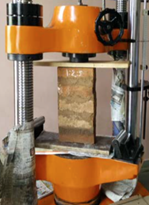 |
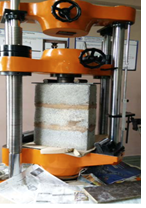 |
Fig. 7 Test setup of brick masonry prism and solid concrete block masonry prism
The variation of compressive strength of various masonry block prisms with fly ash based geopolymer mortar is shown in Fig. 8.
Fig. 8 Variation of compressive strength of different masonry prisms
The variations of typical stress-strain parameters for masonry prisms is as shown in Fig. 9 for each type of masonry units. It can be observed that the variation of stress with strain is not linear and the initial tangent modulus for brick masonry prism was found to be 8886 MPa. For the solid concrete block masonry prism, modulus was 9348 MPa and Stabilized geopolymer block masonry prism, modulus was found to be 10490 MPa. The values of modulus, compressive strength and the mode of failure are as tabulated in Table.5.
Fig. 9 Stress-strain plot of masonry prisms with geopolymer mortar
Table V. Properties of masonry prisms with geopolymer mortar
| Sl. No. | Masonry Prism | Compressive Strength (MPa) at the age of 28 days | Initial Tangent Modulus (MPa) | Failure Pattern observed |
| 1 | Burnt clay brick | 3.6 | 8886 | Crushing of bottom most block and vertical cracks |
| 2 | Solid Concrete Block | 5.8 | 9348 | Crushing of blocks and vertical cracks |
| 3 | Stabilized Geopolymer block | 8.7 | 10490 | Vertical cracks propagating from the top and spalling till the bottom block |
It was observed that the strength of masonry prism with geopolymer mortar showed good bond strength rather than using traditional cement mortars. Vertical cracks were seen in the prisms which extended from top of the block and propagated till the bottom of the block in the prism. It was observed that that bottommost block in the prism was ruptured to a considerable extent compared to the other blocks.
CONCLUSION
Stabilized geopolymer mud blocks are high strength and high-density blocks.
The compressive strength of ambient cured fly ash based geopolymer blocks achieve good compressive strength of about 24MPa at age of 28 days and water absorption is less which makes it a good building material.
The optimum compressive strength of geopolymer mortars was found to be 10MPa with the mortar mix of Fly ash GPM S/FA 0.5
The study on structural behavior of stabilized geopolymer block masonry shows enhanced compressive strength of masonry with geopolymer mortar similar to cement mortars.
Maximum stresses were found at the mortar interface in the masonry prism model.
The mode of failure was either Shear break type of failure or Face shell separation type of failure.
Fly ash achieve good results when used as a binder and for the synthesis of geopolymers.
SGMBs can be used assuredly used as an alternative building material.
REFERENCES
- Venu Madhava Rao K., Venkatarama Reddy B. V., and Jagadish K. S., “Flexural bond strength of masonry using various blocks and mortars.”, Materials and Structures, 29(2), 119-124, 1996 RILEM.
- B. V. Venkatarama Reddy and A. Gupta, “Characteristics of soil-cement blocks using highly sandy soils ‘’ Materials and Structures 38, 2005 RILEM.
- HB Kaushik, DC Rai, and SK Jain. “Stress-strain characteristics of clay brick masonry under uniaxial compression”, Journal of Materials in Civil Engineering, 19(9):728–739, 2007.
- A Costigan and S Pavia. “Compressive, flexural and bond strength of brick/lime mortar masonry”, International Conference on Protection of Historical Buildings:PROHITEC-09, June 21-24, Rome, pages 1609–1615, 2009.
- S Vimala and K Kumarasamy. Studies on the strength of stabilized mud block masonry using different mortar proportions. International Journal of Emerging Technology and Advanced Engineering, 4(4):720–724, 2014.
- M K Maroliya,2012 “Load Carrying Capacity of Hollow Concrete Block Masonry Wall” International Journal of Engineering Research and Applications.
- Ernesto S. Fortes, Guilherme A. Parsekian and Fernando S. Fonseca, A.M.ASCE, 2014“Relationship between the Compressive Strength of Concrete Masonry and the Compressive Strength of Concrete Masonry Units” American Society of Civil Engineers.
- Joseph Davidovits, “Properties of geopolymer cements”, Proceedings of Kiev state technical university conference, Ukraine, 1994, pp 131-149.
- Venkatarama Reddy and Ajay Gupta, Strength and elastic properties of stabilized mud block masonry using cement-soil mortars, J. Mat. Civ. Engin., 3(1), 472- 476, (2006).
- Andri Kusbiantoro, Muhd Fadhil Nuruddin b, Nasir Shafiq b and Sobia Anwar Qazi, “The effect of microwave incinerated rice husk ash on the compressive and bond strength of fly ash based geopolymer concrete” Construction and Building Materials, 2012, 36, pp. 695.
- G Sarangapani, BV Venkatarama Reddy, and KS Jagadish. Brick-mortar bond and masonry compressive strength. Journal of Materials in Civil Engineering, 17(2):229–237, 2005.
- Radhakrishna, Shashishankar A., Udayashankar.B.C and Renuka Devi. M.V., “Compressive Strength Assessment of Geopolymer Composites by a Phenomenological Model” Journal of Reinforced Plastics and Composites, 4 Vol. 29, No. 6/2010 pp 840-852.
- Radhakrishna, Renuka Devi. M.V. and Udayashankar. B. C. “Use of fly ash in Construction Industry for sustainable development” Journal of Environmental Research and Development, volume 03, 2009, pp1211- 1221.
- Radhakrishna, Shashishankar A. and Udayashankar. B. C “Analysis and Assessment of Strength Development in Class F Fly Ash Based Compressed Geopolymer Blocks” Indian Concrete Journal, Aug 2008, Vol 82, No.8.pp.31-37.
- Nanjunda Rao. K. S, “Structural masonry: properties and behavior”, department of civil engineering, IISc, Bangalore, 1986.
- Hala A. Hossein, Esmat M.A. Hamzawy, Gehan T. El-Bassyouni, Bassem S. Nabawy, “Mechanical and physical properties of synthetic sustainable geopolymer binders manufactured using rockwool, granulated slag, and silica fume”, Construction and Building Materials, Vol 367, 2023, 130143, ISSN 0950-0618, https://doi.org/10.1016/j.conbuildmat.2022.130143.
- Sanad, Samah & Moniem, Shimaa & Abdel-Latif, Mahmoud & Hossein, Hala & El-Mahllawy, Medhat. (2021). “Sustainable management of basalt in clay brick industry after its application in heavy metals removal”, Journal of Materials Research and Technology. 10. 10.1016/j.jmrt.2020.12.070.
- IS 3812:1981: Code of Practice for “Specification for Fly Ash for Use as Pozzolana”, Bureau of Indian standards, New Delhi, India.
- IS 1077-1992: “Common burnt clay building bricks”- Specification, Bureau of Indian standards, New Delhi, India.
- IS 3495 (parts 1 to 4)-1992: “Methods of tests of burnt clay building bricks”, Bureau of Indian standards, New Delhi, India.
- ASTM C67: “Standard test methods for sampling and testing brick and structural clay tile”.
- ASTM C109 “Standard Test Method for Compressive Strength of Hydraulic Cement Mortars”
- ASTM C1314-03b: Standard Test Method for Constructing and Testing Masonry Prisms.




